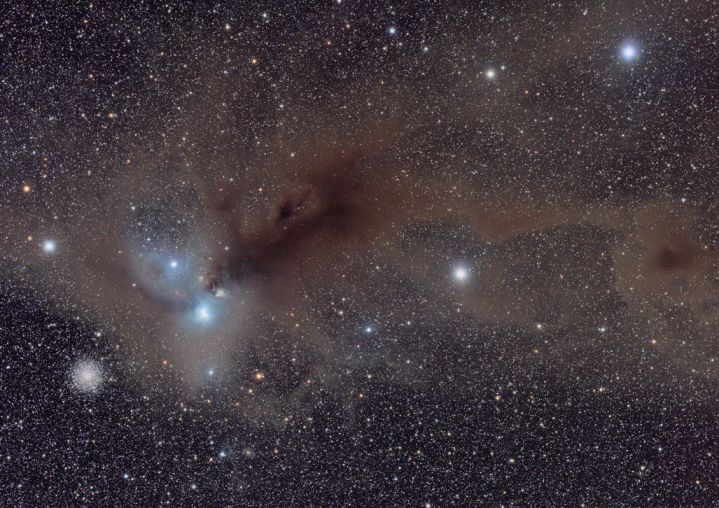
|
Credit & Copyright: Loke Kun Tan
(StarryScapes)
Explanation:
A cosmic dust cloud sprawls across a rich field of stars in
this gorgeous wide field telescopic vista looking toward
Corona Australis, the Southern Crown.
Probably less than 500 light-years away and
effectively blocking light from
more distant, background stars in the Milky Way, the densest
part of the dust cloud is about 8 light-years long.
At its tip
(lower left) are a series of lovely blue nebulae cataloged as
NGC 6726, 6727, and 6729.
Their characteristic blue color is produced as light
from hot stars is reflected by
the cosmic dust.
The tiny but intriguing yellowish arc visible near
the blue nebulae marks young variable star
R Corona Australis.
Magnificent
globular star cluster NGC 6723
is seen here
below and left of the nebulae.
While NGC 6723 appears to be just outside
Corona Australis in the constellation Sagittarius,
it actually lies nearly 30,000 light-years away, far beyond
the Corona Australis dust cloud.
|
January February March April May June July August September October November December |
| ||||||||||||||||||||||||||||||||||||||||||||||||
NASA Web Site Statements, Warnings, and Disclaimers
NASA Official: Jay Norris. Specific rights apply.
A service of: LHEA at NASA / GSFC
& Michigan Tech. U.
Based on Astronomy Picture
Of the Day
Publications with keywords: dust - Corona Australis - dark nebula - reflection nebula - globular cluster
Publications with words: dust - Corona Australis - dark nebula - reflection nebula - globular cluster
See also:
- APOD: 2025 September 19 Á The NGC 6914 Complex
- APOD: 2025 September 5 Á 47 Tucanae: Globular Star Cluster
- APOD: 2025 August 28 Á Galaxies, Stars, and Dust
- APOD: 2025 August 14 Á M13: The Great Globular Cluster in Hercules
- APOD: 2025 July 26 Á Globular Cluster Omega Centauri
- NGC6366 vs 47 Ophiuchi
- Reflections on VdB 31
